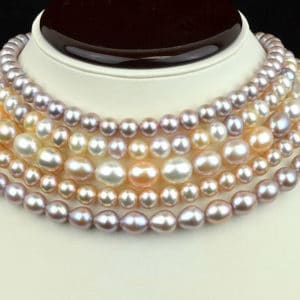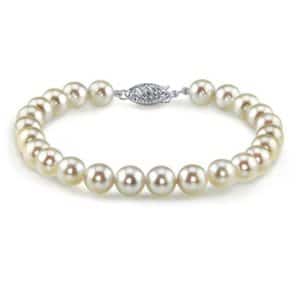

Re-stringing Pearls and Beads
Re-stringing pearls is a must for this popular and classic jewelry. Whether they’re necklaces, bracelets, or anklets, pearls are among the most popular pieces. They’re among the most-loved versatile jewelry looks. Pearls instantly add a touch of glam and sophistication to any outfit in any situation.
However, no strand of pearls will last forever. No matter what material was used to string it. There are a number of materials on which pearls can be strung: wire, monofilament, very thin chain, or thread made of silk, nylon, or polyester.
Routine Maintenance
Re-stringing pearls and bead strands are part of the occasional maintenance necessary to keep them intact and looking their best.
As the strand is worn, it comes up against day to day abuses. Body oils, residue from perfumes, makeup and lotions create a buildup of things that are harmful to the pearl and the stringing material.
In addition, the natural movement of the piece and bumps or snags to the strand causes stress on the string. Even if a necklace, bracelet, or anklet is treated with the utmost care, it will stretch out over the years and will eventually break. Obviously, breakage could result in the loss of one or more pearls, and it could potentially be an embarrassment if it occurs in a public place.
Therefore, it’s important to pay attention to the condition of your strand of pearls and have it re-strung before disaster strikes.
At Copeland Jewelers, we take great care when re-stringing pearls. We like to make sure they get a careful cleaning when necessary before the re-stringing.
Since pearls tend to get perfume, lotions and, heaven forbid, hairspray on them, this makes a gentle cleaning important. Consult with us and we’ll be happy to help you take care of these beautiful organic gems.

When is it Time to Re-string Pearls?
The time is right when you first notice any extra space between the individual pearls that wasn’t present when the piece was purchased or after it was last re-strung. When you notice any discoloration, fraying, or other signs of wear of the stringing material. Then you know it’s time to get the strand to a jeweler to prevent potential problems.
With multi-strand necklaces or bracelets, you may only question the integrity of one of the strands. However, it’s better to go ahead and have the entire piece re-strung at once.
If one strand looks iffy now, it’s likely that the others will develop problems very soon. Stretching out is a sign that re-stringing is necessary.
In comparison, when a strand of pearls is re-strung, it usually leaves the jewelry slightly shorter than it was prior to re-stringing. So, it’s important to get all strands of a multi-strand piece redone at once making sure each strand remains proportioned and hanging properly with each other.
What’s the Benefit of Knots Between Each Pearl?
Well, with knots between each pearl, if the strand ever breaks at a one spot, only one pearl will fall off. And, you may even be able to catch that one single bead! Without the knots, if the string breaks, all the pearls will fall off at once, bouncing and rolling every which way. What a nightmare!
Sometimes people want their strings of pearls to be double-knotted. But this is not a good idea. First, it doesn’t make the strand any stronger. Next, it requires more material and more work. Therefore, likely to mean more expense to the customer. Finally, it keeps the piece from laying correctly when it’s worn. One knot between each pearl is the best idea – no more, no less.
Let our manager, Katy, give you advice on re-stringing pearls and beads with a quick visual of your strands. She can recommend what’s necessary to keep your pearls and beads in their best condition, especially those multi-strand pieces.
Re-stringing Experience Counts
Stringing pearls is a very particular art, one that not all bench jewelers are trained in.
At Copeland Jewelers, our manager is professional pearl stringer, Katy Sebree. With over twenty-five years of experience, she will string your pearls on the appropriate silk thread, placing a knot between each bead.
If you have any questions about the integrity of your strands of pearls or want to learn more about the intricacies of pearl stringing, come into Copeland Jewelers in Austin today!
